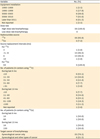1. Gerbaulet A, Potter R, Mazeron JF, Meertens H, Limbergen EV. The GEC ESTRO handbook of brachytherapy. Brussel: ESTRO;2002.
2. Ji YH, Jung H, Yang K, Cho CK, Yoo SY, Yoo HJ, et al. Trends for the past 10 years and international comparisons of the structure of Korean radiation oncology. Jpn J Clin Oncol. 2010; 40:470–475.
3. Jung KW, Won YJ, Kong HJ, Oh CM, Cho H, Lee DH, et al. Cancer statistics in Korea: incidence, mortality, survival, and prevalence in 2012. Cancer Res Treat. 2015; 47:127–141.
4. The Korean Society for Radiation Oncology. The 30 years history of the Korean Society for Radiation Oncology. Goyang: The Korean Society for Radiation Oncology;2012.
5. Guedea F, Hoskin P, Mazeron JJ, Ventura M, Londres B, Bilbao P, et al. Brachytherapy in the United Kingdom and Spain: a subset analysis of a European pattern of care survey. Clin Transl Oncol. 2009; 11:534–538.
6. Rose J, McLaughlin PY, Falkson CB. Brachytherapy practice across Canada: a survey of workforce and barriers. Brachytherapy. 2013; 12:615–621.
7. Marnitz S, Köhler C, Rauer A, Schneider A, Budach V, Tsunoda A, et al. Patterns of care in patients with cervical cancer 2012: results of a survey among German radiotherapy departments and out-patient health care centers. Strahlenther Onkol. 2014; 190:34–40.
8. Guedea F, Venselaar J, Hoskin P, Hellebust TP, Peiffert D, Londres B, et al. Patterns of care for brachytherapy in Europe: updated results. Radiother Oncol. 2010; 97:514–520.
9. Guedea F, Ventura M, Londres B, Pinillos L, Poitevin A, Ospino R, et al. Overview of brachytherapy resources in Latin America: a patterns-of-care survey. Brachytherapy. 2011; 10:363–368.
10. Han K, Milosevic M, Fyles A, Pintilie M, Viswanathan AN. Trends in the utilization of brachytherapy in cervical cancer in the United States. Int J Radiat Oncol Biol Phys. 2013; 87:111–119.
11. Gill BS, Lin JF, Krivak TC, Sukumvanich P, Laskey RA, Ross MS, et al. National Cancer Data Base analysis of radiation therapy consolidation modality for cervical cancer: the impact of new technological advancements. Int J Radiat Oncol Biol Phys. 2014; 90:1083–1090.
12. Song S, Rudra S, Hasselle MD, Dorn PL, Mell LK, Mundt AJ, et al. The effect of treatment time in locally advanced cervical cancer in the era of concurrent chemoradiotherapy. Cancer. 2013; 119:325–331.
13. Health Insurance Review and Assessment Service. National health insurance program 2015. Wonju: HIRA;2015.
14. Nag S, Dally M, de la Torre M, Tatsuzaki H, Kizilbash N, Kurusun S, et al. Recommendations for implementation of high dose rate 192Ir brachytherapy in developing countries by the Advisory Group of International Atomic Energy Agency. Radiother Oncol. 2002; 64:297–308.
15. Kim H, Rajagopalan MS, Beriwal S, Huq MS, Smith KJ. Cost-effectiveness analysis of 3D image-guided brachytherapy compared with 2D brachytherapy in the treatment of locally advanced cervical cancer. Brachytherapy. 2015; 14:29–36.
16. Nag S, Orton C, Young D, Erickson B. The American brachytherapy society survey of brachytherapy practice for carcinoma of the cervix in the United States. Gynecol Oncol. 1999; 73:111–118.
17. Tanderup K, Eifel PJ, Yashar CM, Pötter R, Grigsby PW. Curative radiation therapy for locally advanced cervical cancer: brachytherapy is NOT optional. Int J Radiat Oncol Biol Phys. 2014; 88:537–539.









 PDF
PDF Citation
Citation Print
Print




 XML Download
XML Download